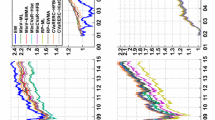Abstract
This paper extends the mathematics developed by Merton (1972) to the limiting investment opportunity set as smaller risk assets are added. Investment opportunity sets of risky assets are well-known to be described by hyperbolae in mean-standard deviation space. In practice, the asset classes in portfolios may vary from high risk common stocks to near cash assets. Low variability assets change the appearance of the investment opportunity set to the extent that a unique optimum risky asset portfolio disappears. The limiting result is similar to the investment opportunity set that arises when two assets are perfectly correlated. The location of the IOS is shown to mathematically depend upon the level of the riskless interest rate and one slope parameter. The slope parameter is estimable, using a finite number of assets, and represents a bound on market Sharpe ratios.
Similar content being viewed by others
References
Buser, S. A. Mean-variance portfolio selection with either a singular or nonsingular covariance matrix, Journal of Financial and Quantitative Analysis, 12, 347–361 (1977).
Chamberlain, G. Funds, factors, and diversification in arbitrage pricing models, Econometrica, 51, 1305–1324 (1983).
Chen, N-F., R. Roll, and S. A. Ross. Economic forces and the stock market, Journal of Business, 59, 383–404 (1986).
Cochrane, J. H. and J. Saá-Requejo. Beyond Arbitrage: “Good-Deal” asset price bounds in incomplete markets, University of Chicago CRSP W.P. 430 (1996).
Fama, E. F. The information in the term structure, Journal of Financial Economics, 13, 509–528 (1984).
Fama, E. F., and M. Gibbons. A comparison of inflation forecasts, Journal of Monetary Economics, 13, 327–348 (1984).
Fama, E. F., and G.W. Schwert. Asset returns and inflation, Journal of Financial Economics, 5, 115–146 (1977).
Ferson, W. Changes in expected security returns, risk, and the level of interest rates, Journal of Finance, 44, 1191–1217 (1989).
Geske, R., and R. Roll. The fiscal and monetary linkage between stock returns and inflation, Journal of Finance, 28, 7–33 (1983).
Graybill, F. A. Introduction to Matrices with Applications to Statistics, (Wadsworth) (1969).
James, C., S. Koreisha, and M. Partch. A VARMA analysis of the causal relations among stock returns, real output, and nominal interest rates, Journal of Finance, 40, 1375–1384 (1985).
Jobson, J. D. and B. Korkie. A note on efficient set mathematics for singular covariance matrices, unpublished, University of Alberta (1978).
Jobson, J. D. and B. Korkie. Estimation for Markowitz efficient portfolios, Journal of the American Statistical Association, 75, 544–554 (1980).
Jobson, J. D. Confidence regions for the mean-variance efficient set: An alternative approach to estimation risk, Review of Quantitative Finance and Accounting, 1, 235–237 (1991).
Kandel, S. On the exclusion of assets from tests of the mean variance efficiency of the market portfolio, Journal of Finance, 39, 63–75 (1984).
Keim, D. B. and R. F. Stambaugh. Predicting returns in the stock and bond markets, Journal of Finance, 487, 357–390 (1986).
Korkie, R. Intertemporal investment opportunity sets and portfolio formation: implications of the assets and the estimation, Proceedings of the Institute for Quantitative Research in Finance, Autumn, Incline Village, Nevada (1994).
Korkie, R. and H. Turtle. Intertemporal variation in investment opportunity sets, unpublished, University of Alberta, (1996).
Markowitz, H. Portfolio selection, Journal of Finance, 7, 77–91 (1952).
Merton, R. C. An analytical derivation of the efficient portfolio frontier, Journal of Financial and Quantitative Analysis, 7, 1851–1872 (1972).
Roll, R. A critique of the asset pricing theory's tests: part I, Journal of Financial Economics, 4, 129–176 (1977).
Ross, S. A. The capital asset pricing model (CAPM), short-sale restrictions and related issues, Journal of Finance, 32, 177–183 (1977).
Solnik, B. The relation between stock prices and inflationary expectations, Journal of Finance, 38, 35–48 (1984).
Stambaugh, R. F. On the exclusion of assets from tests of the two-parameter model: A sensitivity analysis, Journal of Financial Economics, 10, 237–268 (1982).
Author information
Authors and Affiliations
Rights and permissions
About this article
Cite this article
Korkie, B., Turtle, H. A Note on the Analytics and Geometry of Limiting Mean—Variance Investment Opportunity Sets. Review of Quantitative Finance and Accounting 9, 289–300 (1997). https://doi.org/10.1023/A:1008235701596
Issue Date:
DOI: https://doi.org/10.1023/A:1008235701596




